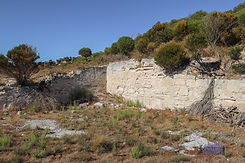
Victory Salt Refinery - Salt Store
Upon returning from World War 1, a party of soldiers, who’d formed the Victory Syndicate, took over a lease of the salt deposits from the Rottnest Board of Control. From what was so far a successful enterprise six weeks into their venture at the time of being interviewed by The West Australian, they were expected to ship an approximate 60 ton a week, until the remainder of the harvesting season.
Harvesting was largely taking place on two ends of Government House Lake, as part of their lease agreement. They were also permitted to harvest Serpentine Lake, which the group hoped to do so “by means of an evaporator plant”.
Changes in the Company
The Victory Salt Refinery on Rottnest Island appears to have been a partnership between Thomas Charles Villiers and Francis Maskiell, although little can be found on the transition that was made from the Victory Syndicate to the Victory Salt Refinery.
The partnership was advertised in The West Australian as being dissolved as of November 1, 1923, with Francis Maskiell retiring, leaving Thomas Villiers to continue the company.
Victory Salt Refinery Limited (VSRL) became a registered company on 16 August 1932, with a head office based in the Royal Insurance Buildings on St Georges Terrace (later the Australasia Chambers at 68 St Georges Terrace, the offices of Conigrave and Co at 44 Adelaide Street in Fremantle and then Centenary Buildings at 2 William Street in Fremantle).
On 25 August 1932, VSRL published an advert to inform the public that they had taken over from “the Executors of the late Mr W B Fallowfield, the business conducted under the name of The Victory Salt Refinery at Rottnest”.
Located in close proximity to Henri Couderot’s Salt Works, VSRL established themselves on the western side of Pearse Lake, which forms part of Government Lake. Digby Road has long since divided the locations of both historic sites.
















On 19 March 1948, VSRL advertised a tender in The Daily News for the purchase of their assets comprising of:
-
The lease of the salt lakes at Rottnest Island, with an expiry date of 30/06/1952
-
A three-bedroom cottage with two verandahs
-
A stone store shed with an asbestos roof which had the capacity to store 750 tons
-
600-800 tons of harvested crude salt
-
Dodge ute (good running order)
-
Morris truck (out of order)
-
Schumarker Mill with elevator and attachments
-
Schumaker Dresser
-
Eclipse Mill with elevator
-
Set Platform Scales
-
7 H.P. Electric Motor and Switch Gear
-
Rakes, forks, barrows and other sundry equipment.
The advert stated that all the items listed would be included in the tender and no tenders would be accepted for individual items.
New Lessee
On January 1, 1954, a Mr Reilly took on a five-year lease of the salt works. As a result of no salt being harvested from Government Lake over the past few years, some 800 tons of good quality salt was expected to be harvested over an 8-9 week period. Due to the good, clear quality of the product, his wife stated that it was, “suitable for refining as table salt… we will sell it in bulk to a Perth manufacturer”.
At the time, Government Lake was the only lake out of the existing six that could be harvested. With a team of six men it was a, “fork-and-barrow job as the salt cannot be taken off mechanically.” After being carted off to the salt works, it was bagged up and then shipped to the mainland.
Remains
When facing the remains of the Victory Salt Refinery from Digby Road, evidence of the old asphalt driveway can be seen. On the left of this by the lake’s edge, was a rectangular building which is yet to be identified. It’s lack of any evidential concrete foundations potentially suggests that it was a transportable building. All that is left is an impression of its existence in the ground, more notable from satellite imagery.














.png)

